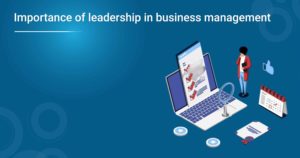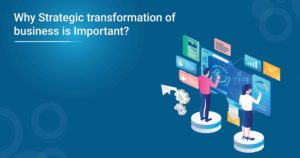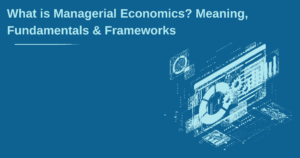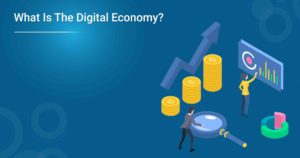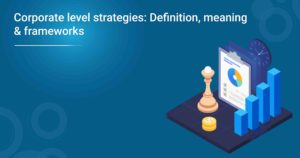Change is an inevitable part of life, which also applies to the workplace. Whether a new process initiative or a restructuring, change management will help you ensure that any transition within your organization is successful. But what is change management? It’s more than just making sure everyone is informed about the development and then expecting them to go along with it.
Change management is a complex process that requires careful planning and execution. In this guide, we will be exploring eleven types of change management, from top-down initiatives to bottom-up approaches. We’ll discuss what each type involves and how they can be used in practice to maximize success when transitioning to new systems or processes in your organization.
Kotter’s Change Management Theory
Kotter’s Change Management Theory is a model used to address the challenge of organizational change. The 8-step process, developed by Harvard Business School professor John Kotter in 1995, is designed to help organizations manage change successfully. It begins with communicating a sense of urgency and establishing a guiding coalition. Step two involves creating the vision for change, and step three focuses on communicating that vision throughout the organization.
Finally, steps seven and eight involve instituting strategies for sustaining momentum and institutionalizing progress made from all other steps taken; this ensures the long-term success of changes implemented within an organization. This approach allows companies to effectively navigate any type of transition period—whether external market forces are driving it or if it’s part of an internal rebranding effort—by following a proven sequence of steps designed to achieve maximum results while minimizing disruption the way.
Features
- Establish a Sense of Urgency: This encourages people to accept that change is necessary, understand its need, and move forward efficiently.
- Form a Powerful Coalition: Assembles strong leaders who are respected and committed to moving the organization towards its goal.
- Develop a Vision and Strategy: Creates long-term goals and outlines can be attained with short-term objectives along the way.
- Communicate the Change Vision: Emphasizes how this new vision will benefit individuals and improve the overall performance of the organization as a whole, leading to acceptance & successful implementation of change within the organization’s culture & structure.
- Enable Action by Removing Barriers: Identifies anything blocking progress towards a desired end state, such as outdated processes or organizational structures, so they can be removed for transformation to take place.
- Generate Short-Term Wins: Achieves quick wins, which help sustain momentum while implementing larger changes over time.
- Create Structural Changes: Reorganizing departments or creating new roles allows employees to have more ownership over their workflows and makes sure tasks flow through all business areas efficiently.
- Anchor New Approaches in Corporate Culture: Prevents further resistance from occurring by having everyone on board with organizational changes made during the transformation process.
Lewin’s Change Management Model
Lewin’s Change Management Model is a three-stage model used to effectively plan and manage change within organizations. American psychologist Kurt Lewin developed the model in the 1950s, which remains one of the most widely accepted approaches to organizational change today. The three stages of Lewin’s Change Management Model are Unfreezing, Changing, and Refreezing.
The first stage of Lewin’s Change Management Model is Unfreezing. This involves analyzing the current situation and identifying any organisational obstacles or resistance to change. It also includes creating an understanding among employees about why changes need to be made, emphasizing how these changes will help meet overall goals for success. During this stage, management needs to create a sense of urgency around the initiative, so everyone understands its importance without causing undue stress or anxiety among staff members.
The second stage is Changing – during this phase, new procedures and processes are implemented to facilitate desired outcomes from implementing change initiatives across departments or units in an organization. Here managers must ensure communication between all stakeholders involved with aligning expectations and providing support throughout implementation processes, such as training sessions or workshops on new methods being adopted into practice.
There will likely still be some resistance, but it should begin to subside at least partially if managed properly. At the same time, people start adjusting their behaviour according to newly implemented systems/processes, etcetera.
Finally comes refreezing, where reinforcement strategies take place. Here leadership should focus on maintaining momentum towards desired objectives through regular measurements, progress checks, feedback loops, etc. Rewards can also play a part in reinforcing positive behaviours, which ultimately leads us back to Unfreezing where we started: making sure there’s still motivation driving our team towards success!
Also Read: Top Interview Questions on Change Management in 2024
Features
- Clear and Structured: Lewin’s change management model provides a clear and structured approach to managing change, allowing for identifying specific steps in the process. This includes an analysis of the current state and planning the desired future state before finally implementing the changes.
- Proven Model: The model has been around since 1947, which makes it a well-tested approach with proven success rates over time. It is one of the most widely used models in organizations as it helps them manage successful transitions through various stages of change.
- Unfreezing & Refreezing: Through this model, organisations can successfully navigate the ”unfreeze-change-refreeze” phases critical to any significant transformation effort. Unfreezing is about creating readiness for change. Refreezing involves establishing new norms and behaviours adapted to suit new conditions created post-transition, effectively consolidating those changes into business outputs or outcomes required from such efforts.
- Involves Everyone: The model encourages participation from all stakeholders affected by organisational change initiatives involving them in decision-making processes related to these changes through gathering their feedback at every stage, thus building strong relationships amongst teams working on these projects.
- Enhanced Acceptance: With everyone involved in initiating and driving organisational modifications, understanding why certain decisions have been taken becomes clearer, leading to increased acceptance levels throughout the organisation and smoother implementation procedures.
- Reflection & Evaluation: Unlike some other management models, Lewin’s Change Management Model encourages managers and leaders alike to reflect upon how effective their strategies were during each phase. Thereby enabling evaluation processes carried out towards the project’s conclusion, which further assists the creation of learning documents containing information regarding successful (or unsuccessful) journeys during the process aiding better-informed choices for upcoming initiatives.
The McKinsey 7-S Change Management Model
The McKinsey 7-S, Change Management Model, is a strategic management model developed by Tom Peters and Robert Waterman, Jr. of the consulting firm McKinsey & Company in the late 1970s. It encapsulates seven essential areas of change that must be addressed for successful organizational transformation: Strategy, Structure, Systems, Shared Values, Style, Staff and Skills.
Strategy defines an organisation’s mission and objectives as well as how it plans to achieve them. Structure outlines how authority and responsibility are divided among different levels or departments within the organisation with its reporting relationships defined accordingly. Systems cover all operational activities, such as procedures or processes used to produce services or products; this includes quality assurance systems, performance measurement systems etc.
Shared values define what values guide employees’ behaviour towards each other and customers. These may include trustworthiness or respect, for example. Style refers to how people interact with one another throughout their roles in the company; it may involve leadership style and communication style, among others, depending on what culture has been established in the organization.
The staff covers recruitment policies surrounding employee selection, such as training programmes provided. At the same time, skills refer more directly to technical abilities required by certain jobs within a given field, e.g., knowledge of software engineering tools being necessary for a developer role in IT sector organisations etc.
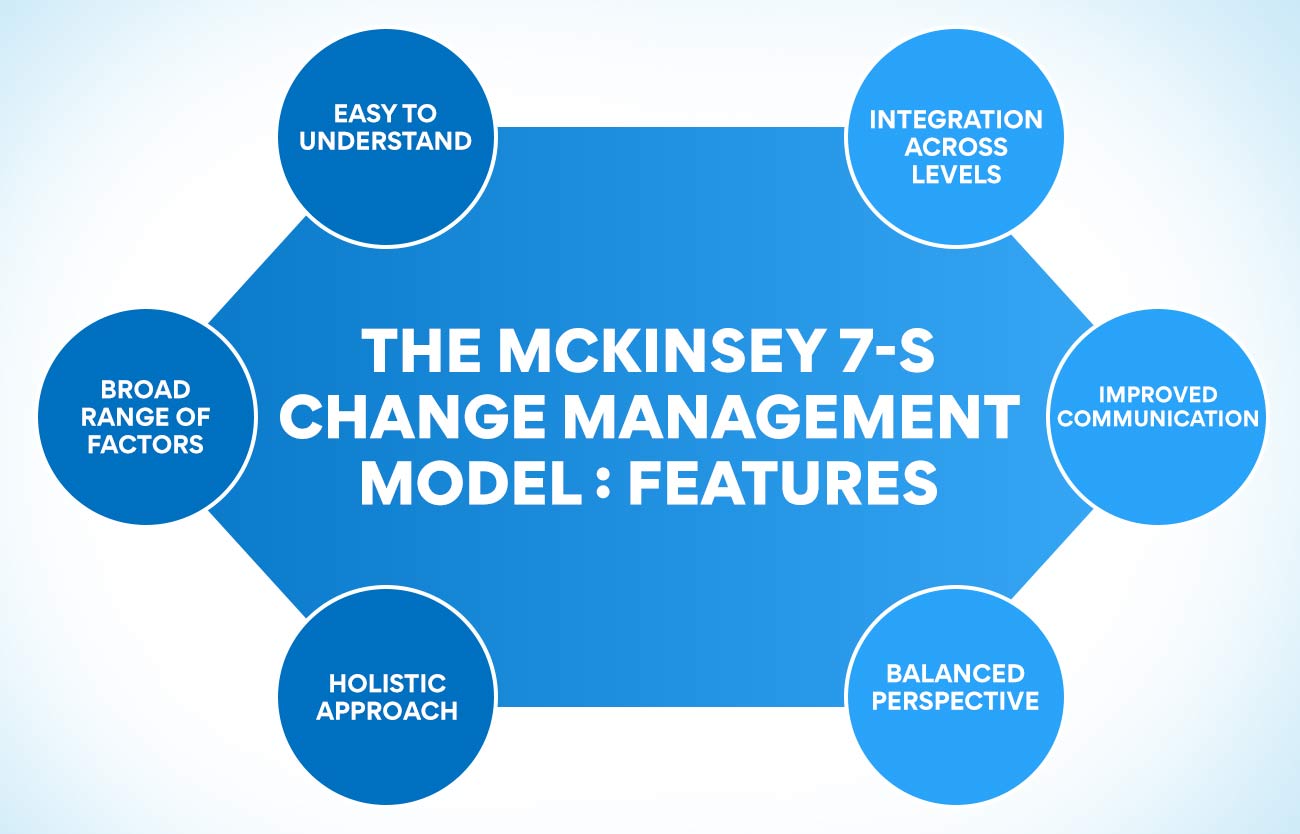
Features
- Easy to Understand: The McKinsey 7-S framework is easy to understand, remember and apply in different situations. It provides a simple yet comprehensive way of looking at organizations and understanding the key elements which need to be addressed for successful change management.
- Broad Range of Factors: One of the benefits of using this model is that it looks at organizational design from multiple perspectives including strategy, structure, systems, shared values, skills, style and staff. This allows managers to identify how these components interact and how changes in one area can affect others.
- Holistic Approach: Unlike traditional models, which focus on one particular element or phase of an organization’s life cycle (i.e., start-up or maturity), the McKinsey 7-S Framework takes a holistic approach by considering all aspects simultaneously when making changes within an organization.
- Integration Across Levels: Another benefit offered by this model is its ability to integrate across different levels within an organization – top-level executives may have long-term visions. Still, they must also consider mid-level operations as well as front-line employees who will ultimately carry out any desired changes necessary for success.
- Improved Communication: Recognizing all elements that need consideration during any change initiative enables improved communication between executive decision-makers and those responsible for implementation.
- Balanced Perspective: Finally, this model ensures that organizations look at both internal (people) factors and external (market) forces while designing their strategy – allowing them to create a balanced view instead of focusing solely on results or profitability.
Nudge theory
Nudge theory is a behavioural change management model which Richard Thaler and Cass Sunstein developed in 2008. It proposes that small, subtle environmental changes can influence people’speople’s decisions and actions in ways that promote better outcomes for them. Nudging presents individuals with choices that encourage or guide them towards making certain decisions.
At its core, nudge theory seeks to make it easier for people to make good choices for themselves without relying on mandates or punishments. For example, if someone needs to save more money but finds it difficult due to their spending habits, nudging methods like automated savings transfers each month can help them stay on track without any external pressure. Similarly, nudges can be used in different organizations and sectors such as healthcare services where providers create incentives around preventive care visits rather than solely focusing on treating illnesses after they have occurred.
In addition, nudge theory also encourages responsibility and autonomy among those being influenced by its tactics; rather than removing choice altogether or imposing unwanted regulations upon individuals, it aims for everyone involved in an organization’s decision-making process (including employees) to take ownership over their behaviour and ultimately lead healthier lives/behave more responsibly when given appropriate guidance. By allowing freedom while still steering people towards desired behaviours, nudge theory provides an effective way of managing change within organisations while still respecting individual preferences as much as possible.
Also Read: Top IIM MBA for Working Professionals in 2024: Choose the Right MBA
Features:
1) Nudges are non-coercive: Nudge theory allows individuals to make choices without being coerced or forced into making decisions they may not want or agree with. This means people can choose what they want, rather than be told what to do by someone else.
2) Improves behaviour: By using nudge techniques, researchers have been able to help improve behaviour around health topics such as physical activity, diet, and smoking cessation, among others.
3) Increase motivation: Nudging encourages action by providing rewards for desired behaviours which helps increase motivation amongst those affected by it. This can lead to more long-term changes in attitudes and actions than traditional enforcement methods or punishment could achieve on their own.
4) Cost savings: Studies have found that nudging is often less expensive than other forms of intervention due to its non-coercive nature, meaning there is no need for costly fines or punishments if a target audience does not respond positively initially – all that needs doing is tweaking the nudge itself until it gets results!
5) Reduces risk of unintended consequences: Since nudges lack coercion, there are fewer risks associated with them than with traditional interventions such as legislation which could unintentionally create new problems (e.g., creating monopolies).
Kübler-Ross Change Curve
The Kübler-Ross change curve is a model of how individuals transition through the stages of change when faced with significant life events. Developed by Elisabeth Kübler- Ross in her 1969 book, On Death and Dying, it has been widely adopted as a useful tool for managing organizational changes.
The Kübler-Ross Change Curve suggests that people go through five stages when faced with major life changes: denial, anger, bargaining, depression and acceptance.
The first stage is Denial—a refusal to accept reality or recognize the implications of an event. This can manifest itself in feelings such as shock or disbelief. During this phase, people may be in complete denial and refuse to accept there’s even a problem they need to address at all.
The second stage is anger over the fact that something needs to change at all, usually directed toward those making them make the transition (in an organizational setting these would be managers). They may become frustrated and lash out verbally due to their perceived lack of control over what’s happening around them during this period.
Bargaining comes next, where people try to negotiate between wanting things to stay status quo and needing something different, which leads them to look for alternative solutions, like agreeing on certain conditions if they must move forward.
Lastly, Acceptance occurs once everything begins coming together. Employees finally realize that a compromise between their ideal situation and reality needs to exist; otherwise, nothing will get done moving forward. This gives them more clarity about what steps need to be taken going forward, leading towards eventual goal completion after persisting through difficult times earlier during the transition process initially outlined within Kübler-Ross Change Curve Model, respectively speaking overall!
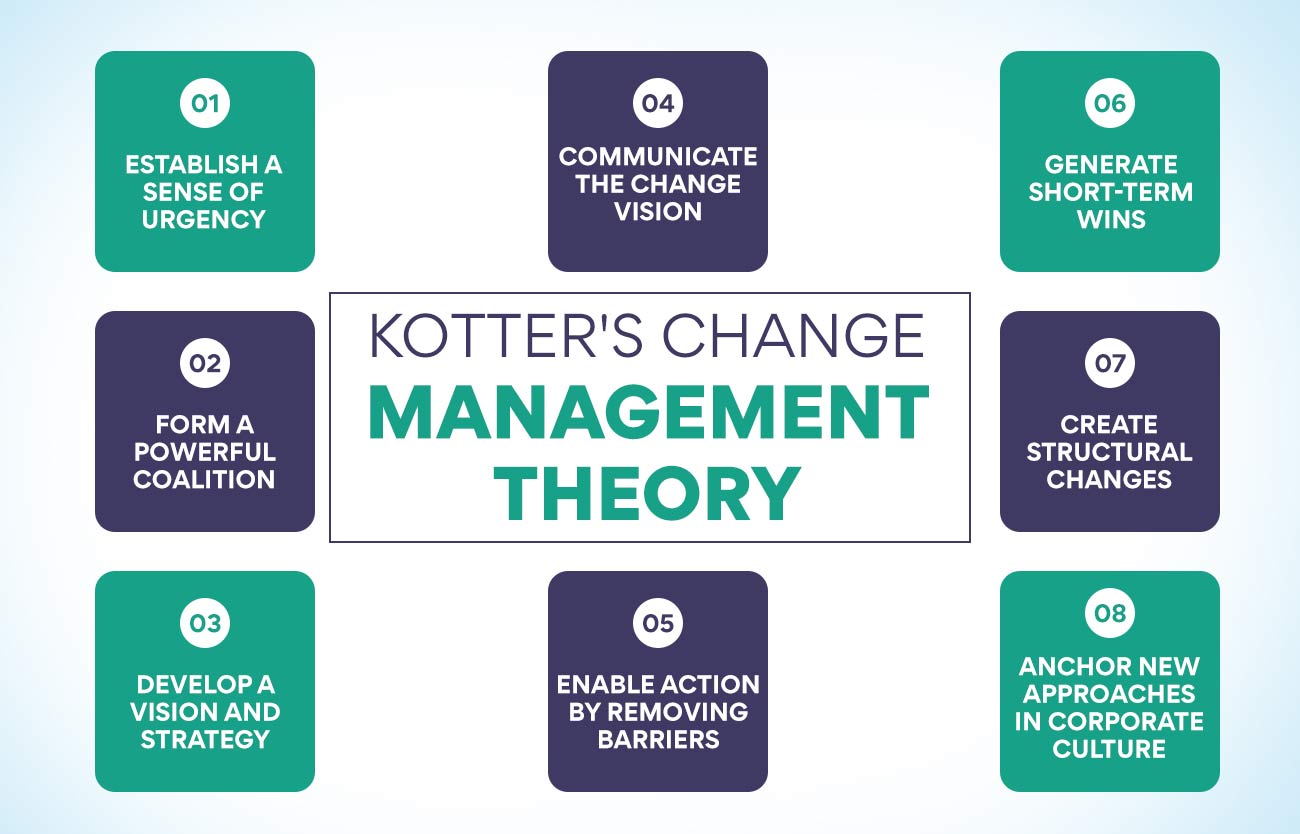
Features
- Provides a framework to understand and explain the stages of grief: The Kübler-Ross Change Curve provides an effective visual representation for understanding and explaining the common stages of grief that individuals experience when dealing with change or loss, such as denial, anger, bargaining, depression and acceptance. This can help those experiencing the emotions associated with these changes and those who support them.
- Helps people identify where they are in their process: By familiarizing oneself with this model, individuals can gain greater insight into which stage they may be in during a particular time frame. Being aware of what one is feeling allows one to better prepare for each stage by having more realistic expectations about how long it will take before moving on to the next level.
- Aids in self-discovery: As people make progress through each stage in life’s journey (e.g., death/loss), they make important discoveries about themselves – learning more about their strengths and weaknesses along the way as well as discovering new ways of coping with difficult situations that might arise later on down life’s road(s).
- Helps reduce stress levels: Knowing there is a set sequence within which things tend to proceed; helps us have faith that something positive will come from our uncomfortable situation (even if we don’t know exactly what it is yet). This reduces much of our anxiety concerning not knowing what lies ahead for us or why certain events occur at times (which often increases our stress levels unnecessarily).
- Encourages personal growth & resilience: The Kübler-Ross Change Curve shows that even though change can be painful at times, it also has its benefits – like stimulating creativity within us, so we feel empowered enough to create new solutions from old problems rather than just dwelling on past issues indefinitely without making any further progress going forward towards bigger goals & dreams!
Conclusion
The ability to effectively manage change is an increasingly important skill for any business today. While there are many different types of change management, the ones outlined in this article provide a comprehensive guide to properly implementing and managing changes within your organization. By leveraging these various methods, organizations can create a culture of continuous improvement and ensure their operations remain flexible enough to adapt quickly and efficiently when needed.
Ultimately, successful change management requires careful planning, effective communication, dedicated leadership, and strong commitment from all levels of staff – both in terms of time and resources. With the right approach in place, organizations can navigate difficult transitions while maintaining productivity and morale throughout the process.
Our Executive Development Programme in General Management is designed for business executives who want to develop their understanding of change management and the various models used. The course covers topics like understanding different types of change, organizational readiness for change, communicating change, leadership during times of transformation, and managing resistance. Participants will be able to define appropriate strategies for managing their organization’s transition from one state to another. Check out the course now.
More Information:
Why Succession Planning Is Important & How To Strategize It?
What are IIM Courses for Working Professionals? How to Choose One?






_1672046778.jpg)





